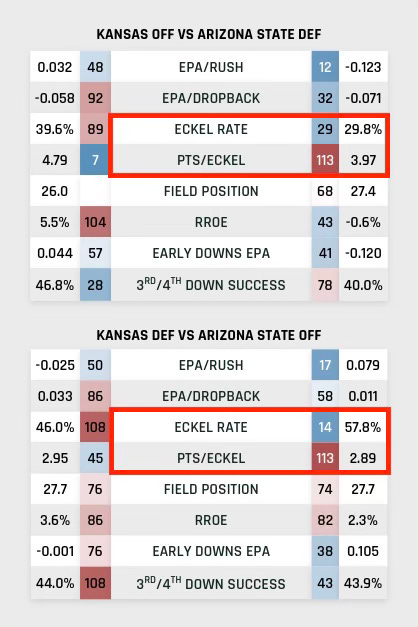Kansas Preview and Some Stats on Finishing Drives
What's an Eckel, and what does it tell us about ASU?
Advanced Stats Preview
ASU takes on Kansas at home this weekend, and here’s the advanced stats preview from College Football Insiders:
They give ASU a 76% win probability and have them favored by about 9.5 points, which is much different from the betting oddsmakers, who only have ASU favored by 3.
ASU’s biggest advantage is when they’re on defense. Kansas has a solid run game (ranked 48th in EPA/rush), but ASU’s run defense is rated even higher (12th in EPA/rush). Kansas’s passing game is below average (92nd in EPA/dropback). Kansas’s passing attack is also ranked low in success rate, which combined with their low EPA, indicates that they have been neither efficient nor explosive. In fact, their EPA being ranked lower than their success rate shows they’re prone to negative big plays - i.e. turnovers, sacks, etc., largely due to Jalon Daniels’ tendency to turn the ball over this season. He also is only averaging 6.2 yds/attempt, a full 3 yards fewer than last season.
ASU also has advantages when they have the ball, but they’re not as big. Kansas’s run defense is fair, but ASU’s run game is above average. ASU’s average passing attack is going up against a Kansas pass defense that is one of the worst among P4 teams.
Eckel: What is it, and what can it tell us about ASU?
Looking at the chart above, the biggest advantages ASU has over Kansas is in Eckel rate and Eckel ratio (both stats have ASU in darkish blue, and Kansas in dark red). But what is Eckel? An Eckel is essentially a productive drive (the stat is named after Kyle Eckel, a former Navy running back), specifically any drive that gets a first down inside the opponent’s 40 yard line, or scores a big play touchdown. The Eckel rate is the % of drives that are productive, and the Eckel ratio is the % of productive drives that belong to you. If you’ve followed advanced stats for a while, Bill Connelly has a stat called opportunity rate that is similar to Eckel rate.
ASU’s Eckel rate and Eckel ratio are quite good, ranked 14th and 19th in FBS, respectively. This means that a lot of ASU’s drives are productive, and they do a good job of limiting productive drives from their opponents.
Point per Eckel
Where ASU has struggled, however, is points/Eckel:
Both on defense and offense, ASU is ranked quite low in Pts/Eckel, meaning they struggle to finish drives. Defensively, they don’t allow teams into scoring position very often, but when they do, they give up points at a high rate. Offensively, they frequently have drives that get inside the opponent’s 40, but they convert those drives into points very poorly.
This is something that has definitely caught Kenny Dillingham’s attention, as he stated that finishing drives was a focus of the bye week. Because of the stark contrast between ASU’s Eckel rate and pts/Eckel, if the focus over the bye week yields even just small improvements in finishing drives, on either offense or defense, it could mean big results.
Let’s take a look at two hypothetical scenarios to see the effect this would have:
ASU makes 5 trips inside their opponent’s 40. These 5 trips result in one touchdown and two field goals, or 13 points. The defense allows only two trips inside their 40, but those two trips result in two TDs. ASU loses 14-13, despite controlling the game and significantly outgaining their opponent.
ASU again makes 5 trips inside the 40. This time, they score 3 TDs and 2 FGs, or 27 points. The defense allows the same 2 trips inside their 40, but the opponent only comes away with 1 FG this time. ASU win easily, 27-3.
The yards and yards/play could be very similar in the two games, but Eckel Rate and Pts/Eckel would tell you what actually happened in the games - ASU controlled both matchups, but their ability to finish drives determined the outcome. The Eckel Rates in both games would be similar (tilted heavily in ASU’s favor), but ASU’s Pts/Eckel in game 1 would be 2.6 and their opponent’s would be 7.0, while in game 2, ASU would have a Pts/Eckel of 5.4 and their opponent’s would be 1.5. This is a good example of what advanced stats can tell you about a game that traditional stats cannot.
This is something to keep an eye on against Kansas, and over the rest of the season.
Big 12 Power Rankings
Last week was chaotic, so there’s quite a bit of movement this week:
BYU
Iowa State
Kansas State
UofA
Utah
Colorado
Texas Tech
UCF
ASU
Cincinnati
TCU
Oklahoma State
West Virginia
Baylor
Kansas
Houston
Again, this is resume-based, so does not reflect how I think the conference standings will finish. While I think Kansas State and Utah are probably still the best two teams in the conference (although not by as much as I previously thought), BYU and Iowa State are clearly deserving of the top two spots right now. Spots 3-10 are a lot more cloudy, and there are several different orderings of those teams that would be defensible.
If you like what you see, please subscribe and share with your friends, and please leave a comment to let me know what you think. Thanks, everyone!





